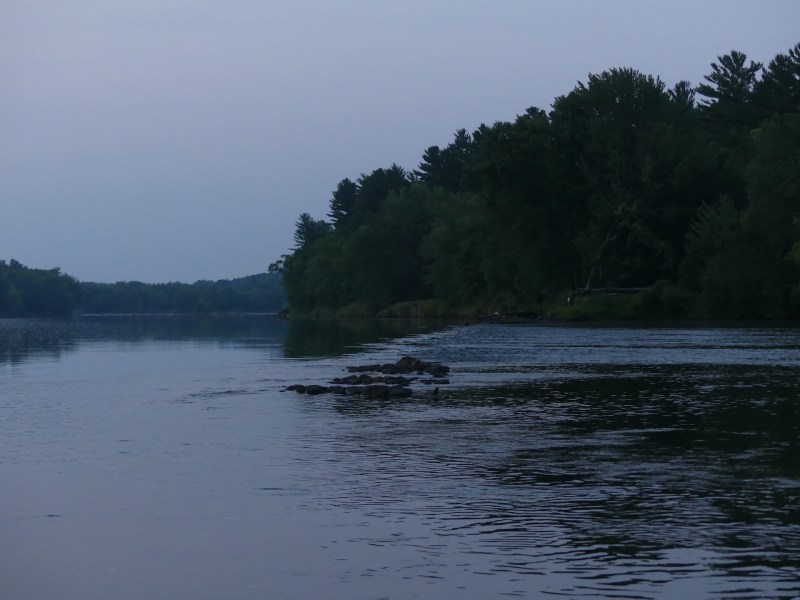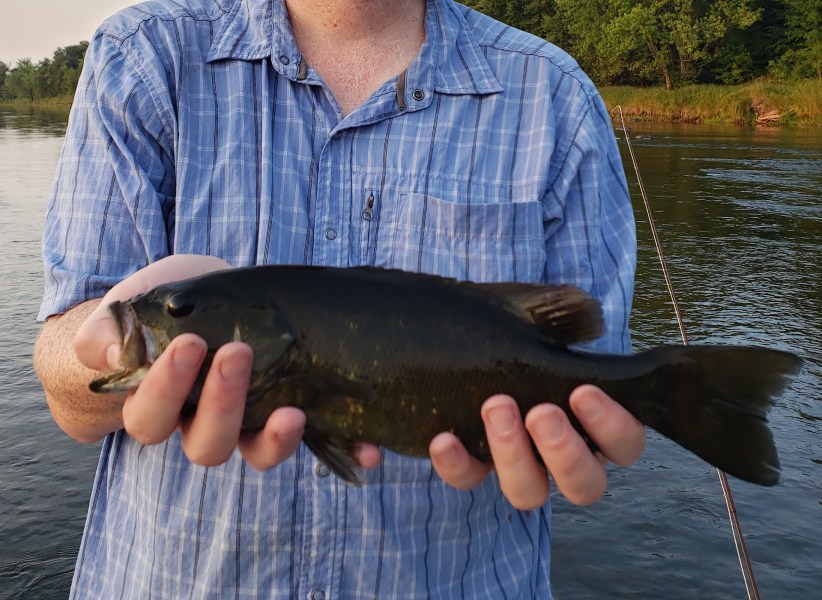Last week I spent an afternoon and evening floating down the St. Croix River near Grantsburg, Wis. I was fly fishing with a friend, taking turns rowing his drift boat and casting for smallmouth bass.
The fishing was slow but a few were brought to the boat. Low, warm water has sent many fish into hiding during the day.
But of course, fish were not the only objective. The river was rich in scenery and wildlife.
Here are some things we saw:
Belted kingfishers. One of these chattering birds crossed the river in front of us not long after launching. They are a species that always challenges me for photography, as they are skittish and seem to fly away as soon as I think about picking up my camera.

Later, we saw three or more of the birds flying all over on the banks. I mentioned to companion I had heard they nest in sandy river banks, which was somewhat surprising. Then we saw a hole near the top of a steep sandy river bank, and wondered if that explained all the birds.
My quest for a decent photo continues.
Wing dams. With the very low water, we could see several of these historic features. They angle downstream, pushing the current toward the center to maintain faster, steadier flow.
I believe the one we saw at dusk that is pictured below was documented by historians Eileen M. McMahon and Theodore J. Karamanski in Time and the River: A History of the Saint Croix as 120 feet long by five feet wide. It kept logs from getting hung up around an island.

A squirrel swimming to Wisconsin. This gray squirrel made good time crossing the St. Croix as we watched and waited for a big predatory fish to grab it.
We’re pretty sure it made it safe.

A sentinel swan. This was the only trumpeter swan we saw all day, perhaps the only waterfowl. We came around an island and it was standing perfectly still in the shallows.
We never saw it move nor heard it make a sound.
Islands and islands. I was reminded how braided the upper river can be. We wove through channels at times, searching out deep enough water to float. Other times it was a single broad channel where one could see a mile down river before the next bend.
The wildfire smoke had mostly lifted, and the sun’s light grew warmer and warmer as it dropped toward the Minnesota side.
Spotted sandpipers. Once you see a few, these birds seem to always be around on the river. They are quite small, skim over the surface when flying, and run back and forth on the abundant beaches and flats.

Late summer flowers. The plants of August say that summer and the growing season are not over quite yet.
Smallmouth bass. “The gamest fish that swims.” No real big ones were caught, but there was enough action to keep us interested. They put a good bend in a fishing rod, alternating between leaping out of the water, “tail walking” across the surface, and then diving and trying to run for cover.
This one shows why they are also known as black bass. And I am not good at holding fish for photos.

Two geologic eras. The banks along this stretch were either sand, sandstone, or hard rocky rubble. My understanding is the soft sedimentary sandstone was deposited by shallow seas about 475 million years ago. The sand and hard rock were left by glaciers about 12,000 years ago.
We sought the sandstone for springs that cooled the river, preferred by fish, and the rocky shorelines, where their food is found. An incomprehensible span of time separated the zones, even though they were intermingled today.
Hanging harebell. Seen on the sandstone outcrop in the first photo above. It is known for living in dry, sandy soil or gravel. Found around the world in the northern hemisphere, it has a special connection to Scotland, according to the U.S. Forest Service:
“Harebell was formerly used in the manufacture of blue dye for tartans and is the symbol of the MacDonald clan. The common name of harebell alludes to the folk beliefs that it either grew in places frequented by hares or that witches used juices squeezed from this flower to transform themselves into hares.”
– Harebell (Campanula rotundifolia L.), USDA Forest Service

A boat on the wrong side of the surface. Bearing not a single piece of wood or other material besides the metal hull, I think this must have been lodged in the river bottom for a good amount of time.

Almost no one. There were a few people launching a boat at a landing we passed, they couldn’t have been planning to go far with the shallow water. A father and son were fishing from shore near their boat across from another landing. At another landing, a couple was sitting in their car blasting music with heavy bass we could hear for several hundred yards, missing out on their chance to enjoy a peaceful and quiet river. But that was it.
Eight miles of river to ourselves.




















Comments
St. Croix 360 offers commenting to support productive discussion. We don’t allow name-calling, personal attacks, or misinformation. This discussion may be heavily moderated and we reserve the right to block nonconstructive comments. Please: Be kind, give others the benefit of the doubt, read the article closely, check your assumptions, and stay curious. Thank you!
“Opinion is really the lowest form of human knowledge. It requires no accountability, no understanding.” – Bill Bullard
5 responses to “Seeing some sights on the upper St. Croix River”
Enjoyed the story, wildlife, and scenery. Thank you.
Always enjoy reading peaceful journeys on the beautiful St. Croix
Greg, Thanks for taking me along for the ride. Not the same as getting my feet wet but your reflections and photos open my eyes to new sights and observations.
I really enjoyed your trip down the river. Thanks for bringing us along with your photographs and descriptions. I didn’t know that there were wing dams in the Saint Croix. Interesting to learn that. I was out yesterday kayaking from Wisconsin interstate Park Franconia and saw some rocky outcrops in the river. Now I wonder if they were wing dams. Because the water is so low we saw a lot of the bottom including quite a few very straight, very long, sunken pine logs. It made me wonder if these might have been lost from during the logging boom in the late 1800s when so many tons of logs were floated down the river. If so, they are unique artifacts of the history of the St. Croix.
3 of us canoed the upper St Croix for 23 miles one day, very memorable though the smallies weren’t biting. One 40 inch muskie was caught and we watched 2 large muskies fly out of the river. They are so fast to any prey entering their area. Eagles followed surface breaching schools of smallies. Miscalculating time and distance we enjoyed the owls as they beckoned nightfall. The only people we saw that day were a welcome sight on this September night that ended in a cold rain. Speaking in foreign tongue they had huge lights up as they fished for cats. They were at our exit point and it was a bit past 10 PM when we left a river that seemed relatively pristine except for 1 tractor tire embedded in the river bottom